This here, this is the way to start the day.
The time is 6:20a, the boat rocks from side to side, sailing up the river, the coffee is piping hot and the kettle next to it is Vietnamese tea that's typically drunk along with the coffee.
After returning from Cambodia to Saigon, back in southern Vietnam, I had one more major attraction to visit - the Mekong delta. The Mekong river is the 13th longest in the world. It starts from Tibet, flows through China, Myanmar, Thailand, Laos, Cambodia and eventually Vietnam. The river's delta has nine major flows into the sea and is called by the locals in Cambodia and Vietnam the river of nine dragons.
The part of the delta that's controlled by Vietnam was originally part of Cambodia, but the Cambodians ceded it Vietnam for political and military help a few hundred years ago. The area still has a large population of Khmers (the major ethnic group in Cambodia) though many Vietnamese have settled here over the years.
Tuoi and I set out on a two day trip to the delta. We did this the local way, by buses and minivans from town to town. Our first stop was about 3 hours away from Saigon. We left early in the morning to beat the tourist crowd. We rented a boat and did a 3-4 hour trip around a few islands in the area.
 The tourist industry has evolved greatly and at every stop there was something for us to see and, more importantly, to buy. This beehive, for example, was part of a demonstration before we were offered some honey and pollen to purchase.
The tourist industry has evolved greatly and at every stop there was something for us to see and, more importantly, to buy. This beehive, for example, was part of a demonstration before we were offered some honey and pollen to purchase.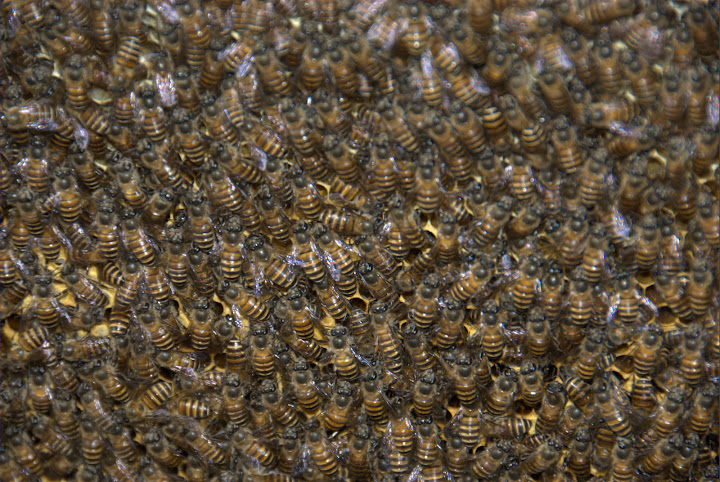 We also saw how coconut candy (highly distilled coconut extract with coloring added from plants) was made.
We also saw how coconut candy (highly distilled coconut extract with coloring added from plants) was made.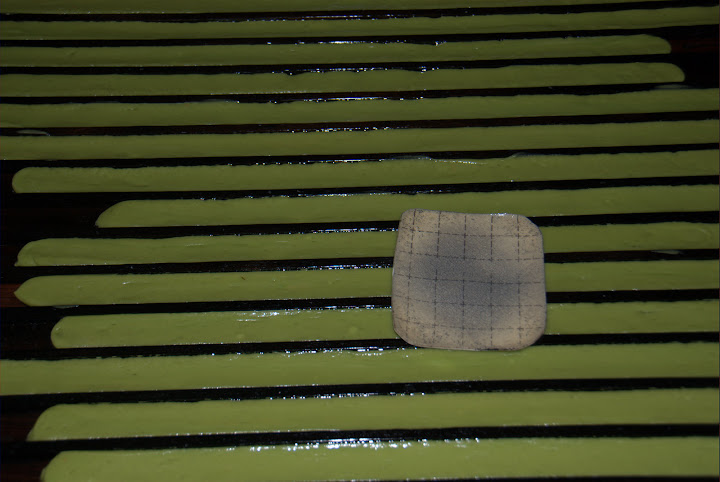 I had a chance to photograph another pool of Koi fish waiting for tourists to feed them. While Tuoi threw fish food pellets into the water, I snapped shots of them swimming in frenzy trying to find all the food.
I had a chance to photograph another pool of Koi fish waiting for tourists to feed them. While Tuoi threw fish food pellets into the water, I snapped shots of them swimming in frenzy trying to find all the food.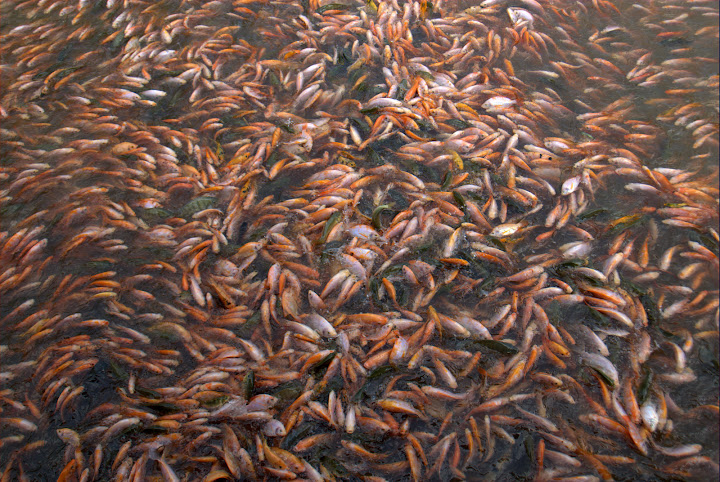 You can also check out the video version of Koi feeding frenzy.
You can also check out the video version of Koi feeding frenzy.We spent the night in Can Tho, a small town near the border with Cambodia. When we arrived, the streets were easily navigable and we had no problem reaching the hotel. When we stepped out an hour or so later, the streets surrounding the hotel were flodded with water at least 4 inches (10 cm) deep. I didn't understand what this was since it did not rain, until Tuoi explained that when the moon is full, the river overflows the streets when high tide comes.
This is a clip shot in Saigon where the same thing happens:
The Floating Markets of Vietnam

And so we woke up early the next day and went on a 7 hour tour of the river. The boat that picked us up was relatively small - space for 4-6 people but it was only the two of us and our driver (sailor?). On the way to the boat, we passed a coffee shop and asked for some coffee. A minute after we climbed onto the boat the coffee arrived along with some tea and we set sail, coffee and all, to see the sights.
 We sailed up the river, dodging river traffic, floating plants and the occasional debris, passing around fishermen sitting in their boats picking fish out of their nets and generally enjoying ourselves.
We sailed up the river, dodging river traffic, floating plants and the occasional debris, passing around fishermen sitting in their boats picking fish out of their nets and generally enjoying ourselves.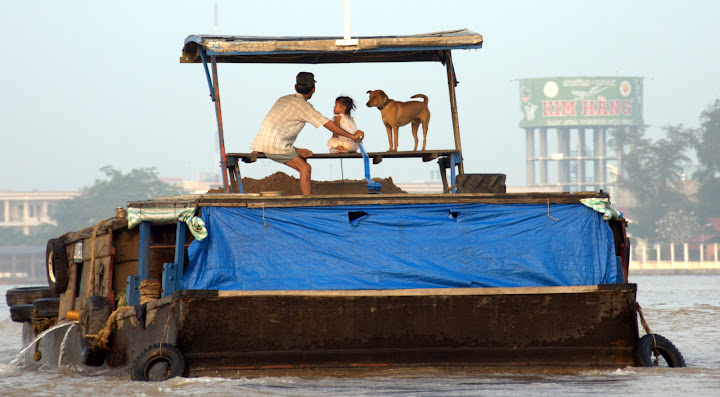 We passed these signs along the way. I've never learned boating and while these signs were posted on the side of the river, I assumed they were targeted at the river traffic. If anyone reading this understands what these say, please add the explanation as a comment at the bottom. I thought about making up my own signs and adding them to the list. Like a diagonal line across an empty sign. Or maybe a dot in the middle of an empty round sign. Or that oh-so-artistic-every-museum-has-to-have-one completely black sign.
We passed these signs along the way. I've never learned boating and while these signs were posted on the side of the river, I assumed they were targeted at the river traffic. If anyone reading this understands what these say, please add the explanation as a comment at the bottom. I thought about making up my own signs and adding them to the list. Like a diagonal line across an empty sign. Or maybe a dot in the middle of an empty round sign. Or that oh-so-artistic-every-museum-has-to-have-one completely black sign.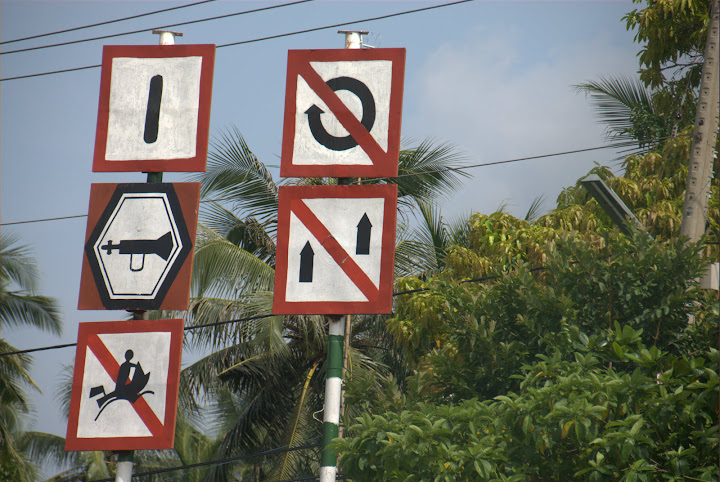 There are two main markets to see in this area. The bigger one is a set of warehouses set along the river bank. Many boats congregate along it, most of them big motorizes boats with large loads.
There are two main markets to see in this area. The bigger one is a set of warehouses set along the river bank. Many boats congregate along it, most of them big motorizes boats with large loads. Breakfast can be had on the river. You simply flag down one of the boats that sell snacks / drinks / sandwiches and order what you want. Notice how this woman uses her foot to steer the boat's motor. Yes - sailing with your feet is big in Vietnam.
Breakfast can be had on the river. You simply flag down one of the boats that sell snacks / drinks / sandwiches and order what you want. Notice how this woman uses her foot to steer the boat's motor. Yes - sailing with your feet is big in Vietnam.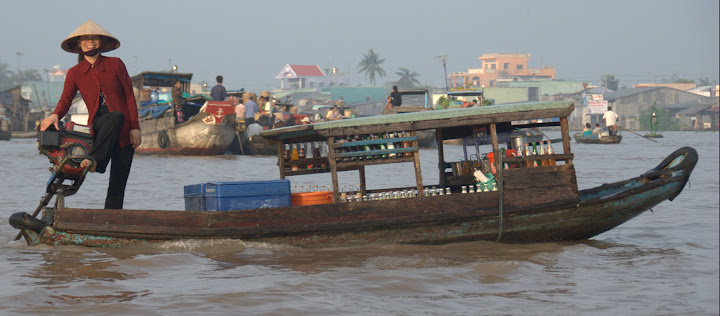 So how do you find what you want to buy? Easy - boats advertise their wares in the simplest way possible.
So how do you find what you want to buy? Easy - boats advertise their wares in the simplest way possible.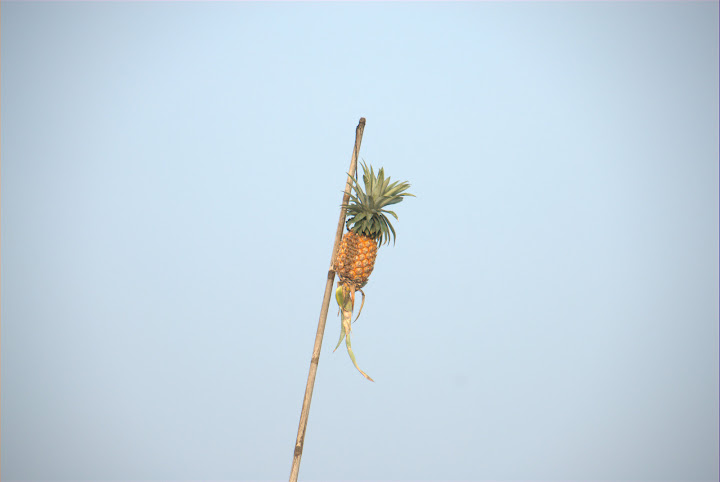 What's tied to the pole above the boats tells you everything you want to know.
What's tied to the pole above the boats tells you everything you want to know.The market has all the roles you'd typically expect from a merchant society. Here's the distribution channel for a pineapple. This is a farmer bringing wares to the market:
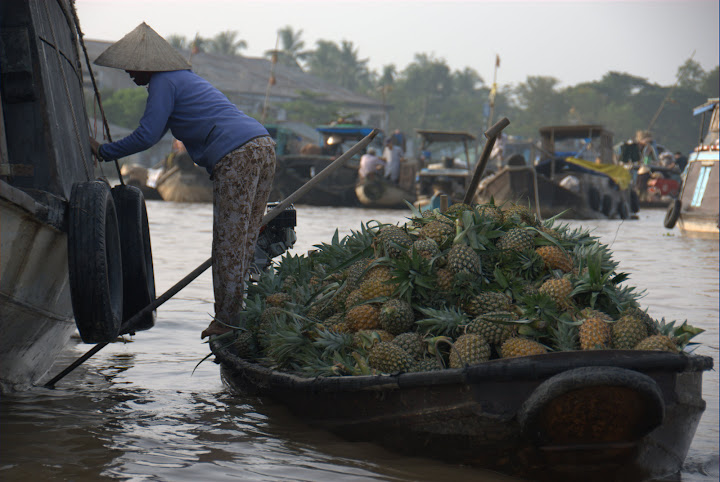 While this is a wholesaler of pineapple, aggregating the produce from many such farmers:
While this is a wholesaler of pineapple, aggregating the produce from many such farmers: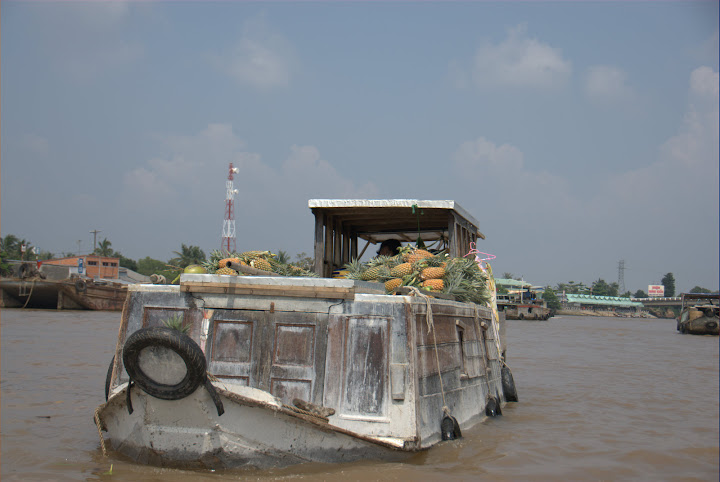
 And you can all guess what this retailer sells:
And you can all guess what this retailer sells: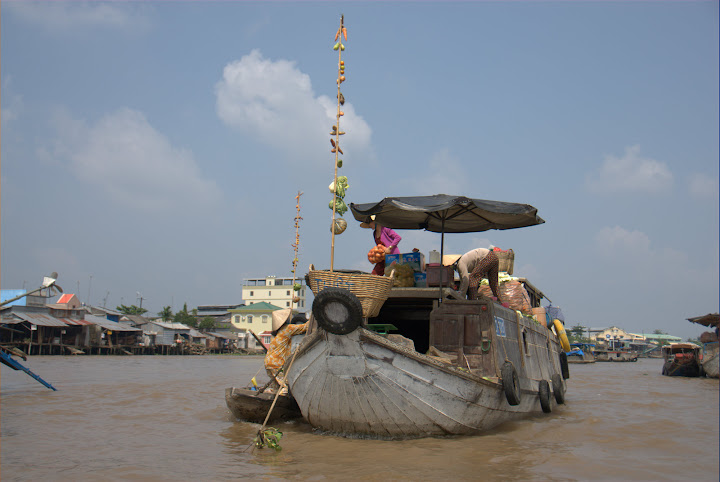
We then made a turn into a small channel that led off between houses and trees to get to the second market. This one was smaller with less large boats around. It seemed more like a local exchange of produce. Most boats were maned by one person and filled with one vegetable or another.
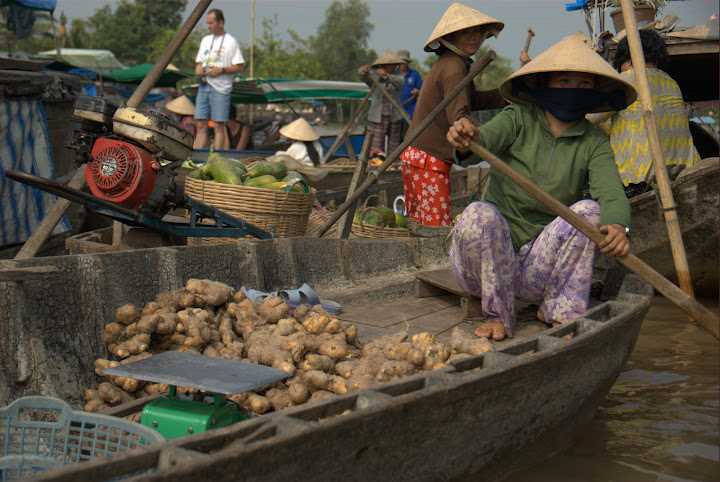 Unlike a regular market where fixed stalls serve as the bargaining place, this market operated using Chaos theory. To enter the market, aim your boat at the center of the throng of boats and turn your motor off. From here on, you'll be pushing into the market using your oars or by manually pulling on other boats. Everyone keeps moving even if they do nothing, on account of everyone else passing by. You're guaranteed to find a way through the market to the other side, it just might take a while.
Unlike a regular market where fixed stalls serve as the bargaining place, this market operated using Chaos theory. To enter the market, aim your boat at the center of the throng of boats and turn your motor off. From here on, you'll be pushing into the market using your oars or by manually pulling on other boats. Everyone keeps moving even if they do nothing, on account of everyone else passing by. You're guaranteed to find a way through the market to the other side, it just might take a while.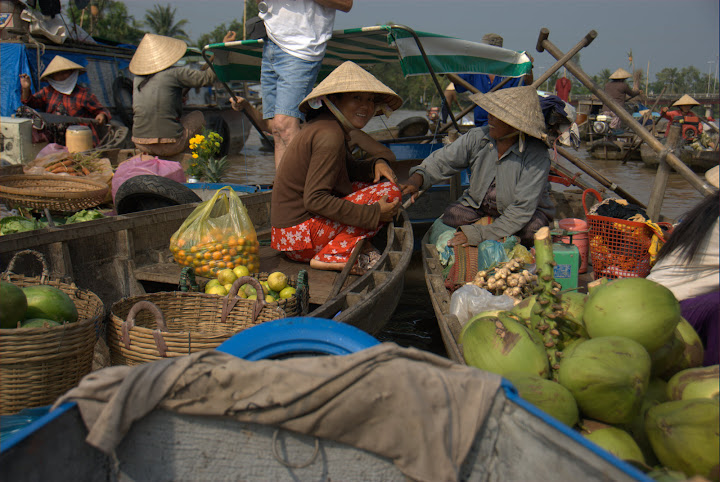 Found a boat you want to stay near for a while? no problem. Tie yourself to the boat and you'll drift off together. We had some pineapple here, then some lunch. We found the noodle-soup selling boat and anchored ourselves next to it. And then we were off back to Saigon.
Found a boat you want to stay near for a while? no problem. Tie yourself to the boat and you'll drift off together. We had some pineapple here, then some lunch. We found the noodle-soup selling boat and anchored ourselves next to it. And then we were off back to Saigon.For more scenes from the river, take a look at the album linked at the top of this entry.
Technorati Tags: Vietnam, Mekong, Mekong Delta, Floating Markets, Eran Davidov, Travel Blogs
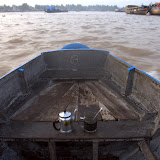
1 comment:
Nice post! It's just now that I've heard of a place flooded by high-tide..never thought that would happen.. Also interesting is the river traffic and the floating market.
Now I know. :) thanks
Post a Comment